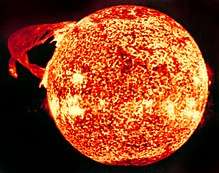PROBA-3
PROBA-3 is the third satellite mission in the European Space Agency's series of PROBA low-cost satellites that are being used to validate new spacecraft technologies while also carrying scientific instruments.
| Mission type | Solar observatory technology demonstrator |
|---|---|
| Operator | ESA |
| Website | link |
| Mission duration | 2 years (nominal) |
| Spacecraft properties | |
| Manufacturer | SENER/QinetiQ/EADS CASA/GMV/SPACEBEL |
| Launch mass | CSC: 339 kilograms (747 lb) OSC: 211 kilograms (465 lb) |
| Dry mass | CSC: 327 kilograms (721 lb) OSC: 190 kilograms (420 lb) |
| Dimensions | CSC: 1.1 by 1.8 by 1.7 metres (3.6 ft × 5.9 ft × 5.6 ft) OSC: 0.9 by 1.4 metres (3.0 ft × 4.6 ft) |
| Start of mission | |
| Launch date | Mid 2022 (planned)[1] |
| Rocket | Vega |
| Launch site | Kourou ELV |
| Contractor | Arianespace |
| Orbital parameters | |
| Reference system | Geocentric |
| Regime | Highly-elliptical Earth Orbit |
| Semi-major axis | 36,943 kilometres (22,955 mi) |
| Eccentricity | 0.8111 |
| Perigee altitude | 600 kilometres (370 mi) |
| Apogee altitude | 60,530 kilometres (37,610 mi) |
| Inclination | 59 degrees |
| Period | 1178 minutes |
| RAAN | 84 degrees |
| Argument of perigee | 188 degrees |
| Epoch | planned |
| Main interferometer | |
| Name | ASPIICS |
| Type | Fabry–Pérot interferometer |
| Diameter | 50 millimetres (2.0 in) |
| Focal length | 1.15 metres (3.8 ft) |
| Wavelengths | visible light |
Overview
PROBA-3 will be composed of two independent, three-axis stabilized spacecraft flying at 150 meters to one another with the ability to accurately control the attitude and separation of the two craft. Their alignment with the Sun will be maintained for 6 hours, creating ″artificial solar eclipse″ for the back satellite. The spacecraft pair will fly a highly elliptical orbit divided between periods of accurate formation flying around apogee, when payload operations will be possible, and periods of free flight. The length of the formation control period will be a trade-off involving the increasing amount of fuel needed to maintain the orbits in formation when away from apogee.[2]
The primary mission of PROBA-3 is solar coronagraphy by using the telescope on the larger of the two satellites to view the Sun's corona while the other spacecraft is maneuvered to accurately occult the disc of the Sun.[3]
As of 2015, PROBA-3 was scheduled to be launched in 2020.[4] By 2018, the launch was delayed to the second quarter of 2021,[5] and by 2020 delayed again to mid-2022.[1] The mission is planned to have a nominal lifetime of around two years.
References
- "About Proba-3". ESA. 10 February 2020. Retrieved 12 February 2020.
- "Mission / PROBA-3". ESA. 13 November 2014. Retrieved 30 November 2015.
- "Science Payload / PROBA-3". ESA. 13 November 2014. Retrieved 30 November 2015.
- "ESA Bulletin 160 (November 2014)" (PDF). ESA. November 2014. p. 61. ISSN 0376-4265. Retrieved 30 November 2015.
- Zhukov, Andrei (22 November 2018). PROBA-3/ASPIICS and its potential synergies with Solar Orbiter/Metis (PDF). 6th Metis Workshop. Göttingen: Max Planck Institute for Solar System Research. Retrieved 13 October 2019.

